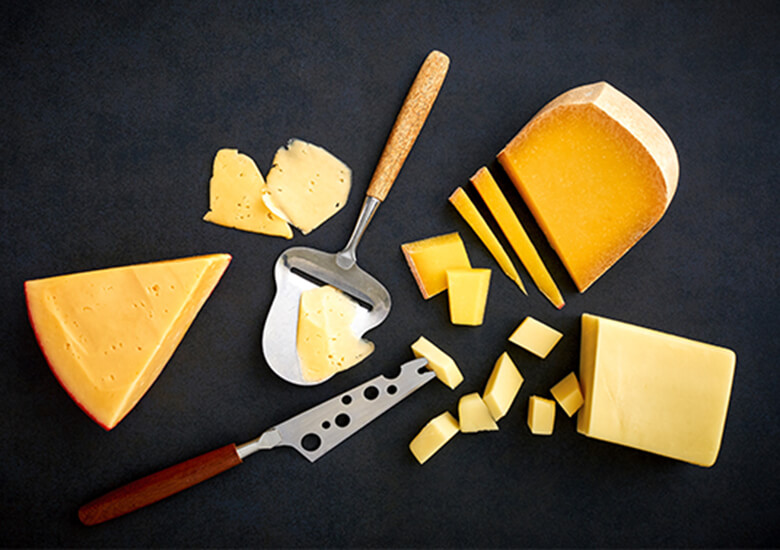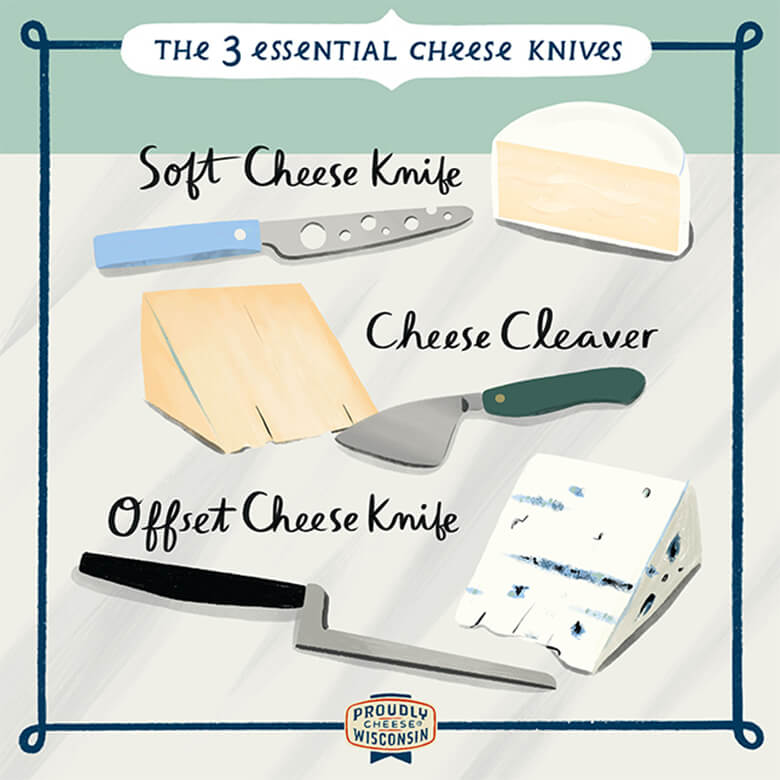Imagine the perfect cheese board in front of you. You spent hours planning all the pairings, visiting your local cheesemonger, and finally, assembling your masterpiece. Just one problem: basic flatware just doesn’t cut it—literally.
Your kitchen knife is too big and unwieldy, and your table knife doesn’t have the oomph to cut through dense parmesan or the finesse to gracefully glide through a soft, creamy blue. Thankfully, there’s a solution. Welcome to the world of cheese knives.
The basics of cheese knives
Cheese knives come in an incredible number of varieties. Short, long, pointy, rounded—whatever you’re looking for, there’s probably a cheese knife out there for you. As a beginner, it can be hard to know which cheese knives are used for what. That’s why we put this guide together so you can wrap your mind around the different options and the cheeses they match.
Types of cheese knives

Soft cheese knife
Whether you’re enjoying a
fresh mozzarella or slicing off a piece of
gorgonzola, the
soft cheese knife is the right tool for the job. Soft cheeses naturally stick to your utensils, so soft cheese knives are strategically built to minimize the surface area that cheese can stick to. By being extremely thin or having holes—not unlike Swiss cheese—these knives are key to a smooth, stick-free cheese cutting experience. Your days of having to use a second knife to scrape cheese off the first knife are over!
Offset cheese knife
If you only want to buy one cheese knife, this is it. Offset cheese knives are sturdy enough to get through firm cheeses like
alpine-style, but feature a thinner blade that won’t stick to delicate soft cheeses. The offset handle that gives this knife its rather lightning bolt profile provides room for the user’s hands and knuckles, allowing for control, leverage, and consistently clean cuts.
Pronged Cheese Knife
This multi-purpose cheese knife is a must-have for any cheese lover. A typical pronged cheese knife can cut everything ranging from firm,
aged cheddar to soft
feta. It’s not quite strong enough to go toe-to-toe with hard cheeses like parmesan, though, and may be a bit thicker than desirable for soft cheeses. It’s the jack-of-all cheese knives but the master of none. The pronged tip can be used for serving or just gazing deeply at the cheese of your choice—we won’t judge.
Cheese cleaver
Yes, it looks exactly like a mini meat cleaver—which is almost reason enough to add this to your cheese knife drawer. The cheese cleaver is what we reach for when cutting firm or semi-hard cheeses like
gouda or
brick. It makes dividing up larger pieces of cheese a breeze.
Flat cheese knife
The flat cheese knife, also known as a cheese chisel, is ideal for shaving or chipping aged hard cheeses like aged gouda or cheddar. As the name suggests, the blade is flat and short so you can apply force straight down on a small area and cut small pieces without crushing surrounding cheeseboard accompaniments.
Spatula cheese knife (or Cheese spreader)
Some cheeses are better spread than cut, and for that, you’ll want a cheese spreader on hand. This basic cheese knife will reinvent the way you spread cream cheese on a bagel. Once you try it, there’s no going back. The spatula blades are intentionally built to gently flex as you apply pressure so that you have even more control over your
cheese smearing skills. Every cheeseboard deserves a spatula knife.
Parmesan knife
We know what you’re thinking: it’s totally unfair that parmesan gets its own knife. This knife originates from Italy where it’s referred to as a “tagliagrana.” It also goes by almond knife or spade knife. Whatever you decide to call it, the
parmesan knife is the tool of choice for cutting hard, granular cheeses like parmesan. The sharp tip easily slices into even the toughest cheeses.
What cheese knives should you get?

While every Cheese Lover dreams of a drawer full of every cheese knife they could dream of, it makes sense to prioritize your purchases for maximum utility. We’d recommend starting with the three cheese knives we couldn’t live without:
• Soft cheese knife
• Offset cheese knife
• Cheese cleaver
These three knives cover everything from soft to hard cheeses while having enough overlap to ensure you’re never left waiting while someone else is holding the knife you need.
Other cheese tools to know

Cheese plane
The best way to get consistent, razor-thin slices is a cheese plane. Although many four-sided cheese graters have one built-in, having a hand-held cheese plane can be a great addition to your cheese tool arsenal when you want the convenience of a smaller, more specialized tool.
Cheese wire
For ultra-delicate cheeses that might get squished with a knife, the cheese wire can be a great way to make cuts without crushing your precious ball of mozzarella. Many cheese boards even have attachments so your cheese wire can attach directly to the board itself!
Ready, set, cut!
Armed with the right tools, you’ll be slicing and dicing Wisconsin Cheese with ease. Find the cheese board to match your new cheese knives with our guide to all things cheeseboards.
If all this talk of cheese has you feeling hungry, try our selection of over 300 handcrafted recipes featuring Wisconsin Cheese. Share your creation with us on Instagram or Facebook and become part of the largest cheese community in the world.
Try out your new cheese knives by getting your favorite Wisconsin Cheeses and cheese gift baskets delivered right to your door with our continuously updated list of cheesemakers and retailers that allow you to order cheese online. Award-winning Wisconsin Cheese is just a click away.
FAQs
What are the differently shaped cheese knives for?
Just like chefs in the kitchen have different knives for cutting different fruits, veggies, or meats, cheese lovers use different knives for different cheeses. Soft cheeses require perforated or thin blades to prevent the cheese from sticking, while hard cheeses like parmesan require a stout blade to chip away small pieces. Each shape has a specific purpose.
What knife is best for cutting cheese?
If you don’t have any cheese knives on hand, we’d recommend using a small paring knife for cutting firm-to-hard cheeses and a thin kitchen knife or butter knife for soft cheeses. While these won’t take the place of a purpose-built cheese knife, they’ll work in a pinch.
Why do cheese knives have holes?
Have you ever been frustrated by cheese that stubbornly sticks to your knife? Some cheese knives have holes to prevent exactly that. The holes give less surface area for the cheese to stick to so your cheese can gently release from the blade rather than clinging on while you scrape it off with another utensil.

If you liked this article, check out these related ones
